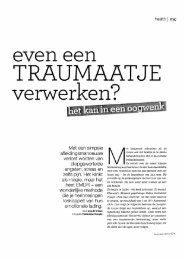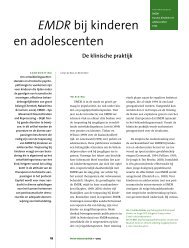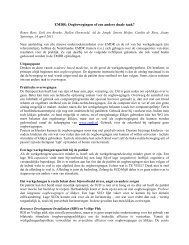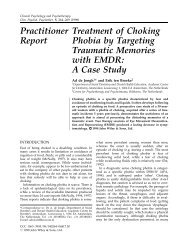Structural Dissociation of the Personality and the Treatment of ...
Structural Dissociation of the Personality and the Treatment of ...
Structural Dissociation of the Personality and the Treatment of ...
You also want an ePaper? Increase the reach of your titles
YUMPU automatically turns print PDFs into web optimized ePapers that Google loves.
Waarom kennis van dissociatie en de<br />
dissociatieve stoornissen noodzakelijk is in de<br />
EMDR-<strong>the</strong>rapie<br />
Waarom kennis van dissociatie<br />
en de dissociatieve stoornissen<br />
noodzakelijk is in de EMDR<strong>the</strong>rapie<br />
Onno van der Hart<br />
www.onnovdhart.nl<br />
6 e EMDR Congres Nederl<strong>and</strong><br />
Arnhem, 24 maart 2012<br />
EMDR <strong>and</strong> complex trauma-related<br />
disorders (including dissociative<br />
disorders) (1)<br />
“By far, <strong>the</strong> greatest number <strong>of</strong> reported<br />
difficulties <strong>and</strong> stories <strong>of</strong> clinical problems<br />
<strong>and</strong> potential harm through <strong>the</strong> improper use<br />
<strong>of</strong> EMDR had involved clients with<br />
dissociative disorders.”<br />
Shapiro (2001, p. 308)<br />
“Many EMDR-trained clinicians are untrained<br />
in dissociative disorders <strong>and</strong> some may not<br />
believe that dissociative conditions exist.”<br />
Paulsen (1995, p. 34)<br />
Increasing attention among EMDR<br />
clinicians for <strong>the</strong>se disorders, for<br />
instance:<br />
Dissociative Disorders Task Force (Fine et al., 1995)<br />
Forgash & Copeley (2008)<br />
Gelinas (1993)<br />
Gonzalez Vazquez (2007)<br />
H<strong>of</strong>mann (2006)<br />
Knipe (2007, 2009)<br />
Lazrove & Fine (1996)<br />
Korn & Leeds (2002)<br />
Oppenheim, Ten Broeke, & De Jongh (2008)<br />
Paulsen (1995, 2007, 2009)<br />
Twombly (2005, 2007)<br />
Warning!<br />
24 maart 2012<br />
6e EMDR Congres, Arnhem<br />
This presentation contains material<br />
that is <strong>of</strong>fensive to some specialists on<br />
dissociation<br />
EMDR <strong>and</strong> complex trauma-related<br />
disorders (including dissociative<br />
disorders) (2)<br />
“Because <strong>of</strong> <strong>the</strong> initial focus on relatively<br />
simple PTSD, EMDR has only lately<br />
addressed issues around pathological<br />
dissociation. Happily, this is precisely <strong>the</strong><br />
area where <strong>the</strong> trauma field’s phase-oriented<br />
approach has built considerable strength. It<br />
would be useful <strong>and</strong> historically this seems<br />
<strong>the</strong> right time, for EMDR clinicians to tap<br />
into that body <strong>of</strong> knowledge.”<br />
Denise Gelinas (2003, pp. 125-6)<br />
Trauma-related Dissociative Disorders are not<br />
rare at all!<br />
EMDR <strong>the</strong>rapists have a high chance to sooner<br />
or later meet clients with complex dissociative<br />
disorders<br />
PREVALENCE<br />
Onno van der Hart 1<br />
2
Waarom kennis van dissociatie en de<br />
dissociatieve stoornissen noodzakelijk is in de<br />
EMDR-<strong>the</strong>rapie<br />
Prevalence <strong>of</strong> dissociative disorders (1)<br />
“Overall, <strong>the</strong> prevalence <strong>of</strong> [DSM-IV]<br />
dissociative disorders in inpatient <strong>and</strong><br />
outpatient psychiatric settings seem to be<br />
around 10%, while approximately half <strong>of</strong><br />
<strong>the</strong>m (5%) has DID, <strong>the</strong> most severe type<br />
<strong>of</strong> dissociative disorders.”<br />
V. Sar (2011)<br />
Prevalence <strong>of</strong> dissociative disorders (2):<br />
Somat<strong>of</strong>orm dissociative disorders<br />
“[T]he ICD-10 includes all manifestations<br />
<strong>of</strong> <strong>the</strong> traditional hysterical neurosis under<br />
<strong>the</strong> rubric <strong>of</strong> dissociative disorders in<br />
accordance with <strong>the</strong> findings <strong>of</strong> modern<br />
studies […]. Thus, epidemiological studies<br />
covering conversion [i.e., somat<strong>of</strong>orm<br />
dissociative] symptoms may providedata<br />
illuminating <strong>the</strong> prevalence <strong>of</strong> dissociative<br />
disorders fur<strong>the</strong>r.”<br />
V. Sar (2011)<br />
Working with patients with complex<br />
dissociative disorders:<br />
The necessity <strong>of</strong> training<br />
“Many <strong>the</strong>rapists begin work with [dissociative]<br />
patients without having become conversant with<br />
<strong>the</strong> dissociative disorders field, its literature, <strong>and</strong><br />
its opportunities for training.<br />
Therapists should not proceed with exploratory<br />
work <strong>of</strong> any sort, access [parts], or press for<br />
historical material until <strong>the</strong>y have <strong>the</strong> expertise to<br />
undertake <strong>the</strong>se endeavors in a manner that is<br />
safe for <strong>the</strong> patient.”<br />
Kluft (2006, pp. 296)<br />
24 maart 2012<br />
6e EMDR Congres, Arnhem<br />
Prevalence <strong>of</strong> Dissociative Disorders<br />
among psychiatric inpatients in Israel<br />
(Ginsberg et al., 2010)<br />
Estimates <strong>of</strong> DD range between 12 <strong>and</strong> 21%<br />
Mainly DDNOS<br />
No indication <strong>of</strong> DD on medical records<br />
Diagnosis <strong>of</strong> personality disorder & psychiatric<br />
comorbidity related to likelihood <strong>of</strong> DD diagnosis<br />
<strong>and</strong> its severity<br />
56.6% had diagnosis <strong>of</strong> schizophrenia; 34.5% <strong>of</strong><br />
affective disorder; 14% personality disorder<br />
Psychiatric comorbidity (1)<br />
“Patients with dissociative disorders have<br />
relatively high number <strong>of</strong> comorbid<br />
diagnoses which may prevent clinicians<br />
from recognizing <strong>the</strong> dissociative disorder<br />
in <strong>the</strong> overal picture.”<br />
V. Sar (2011)<br />
All this is about (complex) dissociative<br />
disorders<br />
BUT HOW ABOUT<br />
DISSOCIATION?<br />
Onno van der Hart 2
Waarom kennis van dissociatie en de<br />
dissociatieve stoornissen noodzakelijk is in de<br />
EMDR-<strong>the</strong>rapie<br />
EMDR <strong>and</strong> <strong>Dissociation</strong><br />
“[P]athological dissociation cannot be<br />
avoided … because EMDR is designed<br />
to treat trauma-related disorders <strong>and</strong><br />
pathological dissociation is a very<br />
prominent feature <strong>of</strong> both peritraumatic<br />
responses <strong>and</strong><br />
posttraumatic conditions.”<br />
Denise Gelinas (2003, p. 123)<br />
<strong>Dissociation</strong>: Point <strong>of</strong> departure<br />
<strong>Dissociation</strong> is not only a sequela <strong>of</strong><br />
trauma, it is not an epi-phenomenon <strong>of</strong><br />
psychological trauma, but it ra<strong>the</strong>r is its<br />
major characteristic<br />
<strong>Dissociation</strong>: that is, dissociation <strong>of</strong> <strong>the</strong><br />
personality<br />
“It is better … to speak <strong>of</strong> dissociation <strong>of</strong><br />
<strong>the</strong> personality.”<br />
William McDougall, 1926, p. 234)<br />
Also simple trauma-related<br />
disorders are dissociative in nature<br />
These disorders, such as PTSD, include<br />
<strong>the</strong> existence <strong>of</strong> traumatic memories:<br />
“The [traumatic] memory was morbific<br />
because it was dissociated. It existed in<br />
isolation, apart from <strong>the</strong> totality <strong>of</strong> <strong>the</strong><br />
sensations <strong>and</strong> ideas which comprised<br />
<strong>the</strong> subject’s personality; it developed<br />
in isolation, without control <strong>and</strong> without<br />
counterpoise.”<br />
Pierre Janet (1919/25, p. 674)<br />
<strong>Dissociation</strong> <strong>and</strong> Trauma-<br />
Related Disorders<br />
“<strong>Dissociation</strong> is increasingly<br />
recognized as a common feature<br />
in various trauma-related<br />
conditions.”<br />
Vedat Sar (211, p. 6)<br />
“Trauma implies dissociation.”<br />
Howell (2011, p. 75)<br />
24 maart 2012<br />
6e EMDR Congres, Arnhem<br />
Back to basics<br />
Also simple trauma-related<br />
disorders are dissociative in nature<br />
“The morbid symptoms disappeared<br />
when <strong>the</strong> memory again was part <strong>of</strong><br />
<strong>the</strong> syn<strong>the</strong>sis that makes up<br />
individuality.”<br />
Pierre Janet (1919/25, p. 674)<br />
Onno van der Hart 3<br />
14
Waarom kennis van dissociatie en de<br />
dissociatieve stoornissen noodzakelijk is in de<br />
EMDR-<strong>the</strong>rapie<br />
The Adaptive Information<br />
Processing Model on Traumatic<br />
Memories<br />
“These unprocessed memories are<br />
stored in isolation, <strong>and</strong> contain <strong>the</strong><br />
affects, thoughts, sensations, <strong>and</strong><br />
behavioral responses that were encoded<br />
at <strong>the</strong> time <strong>of</strong> <strong>the</strong> event.”<br />
Francien Shapiro (2009)<br />
Janet’s view <strong>of</strong> a century ago <strong>and</strong><br />
Shapiro’s more recent formulation are<br />
highly compatible<br />
Traumatic memories are not just<br />
(dysfunctionally stored) information<br />
In dissociative individuals, traumatic<br />
memories (<strong>and</strong> emotions etc.) do not<br />
exist in a psychological vacuum, but are<br />
always a part <strong>of</strong> “ some [part <strong>of</strong> <strong>the</strong>]<br />
personality”<br />
T. W. Mitchell (1922, p. 113)<br />
… a “self-conscious purposive thinking <strong>of</strong><br />
a [part <strong>of</strong> <strong>the</strong>] personality”<br />
W. McDougall (1926, p. 543)<br />
“All <strong>of</strong> us have<br />
our breaking-<br />
point. To some<br />
it comes sooner<br />
than to o<strong>the</strong>rs.”<br />
-T.A. Ross (1941,<br />
p. 66)<br />
24 maart 2012<br />
6e EMDR Congres, Arnhem<br />
Compatibility between Janet’s early<br />
view <strong>and</strong> AIP<br />
Janet’s “dissociated” <strong>and</strong> Shapiro’s “in<br />
isolation” refer to <strong>the</strong> same phenomenon<br />
(Janet also spoke about “isolated”)<br />
There is compatibility between AIP <strong>and</strong><br />
Janet’s original formulation:<br />
dysfunctionally stored memories can be<br />
conceptualized as traumatic memories<br />
dissociated from <strong>the</strong> remainder <strong>of</strong> <strong>the</strong><br />
personality<br />
But <strong>the</strong>re is more…<br />
Traumatic Experiences as<br />
“Breaking-Points”<br />
Subjective experiences <strong>of</strong><br />
breaking-points<br />
“I felt as though I was falling apart”<br />
“I was shattered”<br />
“I was beside myself”<br />
“I felt cracked open”<br />
“It broke me”<br />
Onno van der Hart 4<br />
22
Waarom kennis van dissociatie en de<br />
dissociatieve stoornissen noodzakelijk is in de<br />
EMDR-<strong>the</strong>rapie<br />
William McDougall on<br />
<strong>Dissociation</strong><br />
“Normal personality, as we know it in<br />
ourselves <strong>and</strong> in our neighbours, is <strong>the</strong><br />
product <strong>of</strong> an integrative process ...<br />
<strong>and</strong> is susceptible to disintegration<br />
that results in <strong>the</strong> manifestation <strong>of</strong> two<br />
or more personalities [i.e., parts <strong>of</strong> <strong>the</strong><br />
personality] in <strong>and</strong> through <strong>the</strong> one<br />
bodily organism.”<br />
W. McDougall (1926, p. 545)<br />
Pierre Janet on Hysteria<br />
Hysteria “is a malady <strong>of</strong> <strong>the</strong> personal<br />
syn<strong>the</strong>sis.”<br />
“Hysteria is a form <strong>of</strong> mental depression<br />
characterized by (1) retraction <strong>of</strong> <strong>the</strong> field <strong>of</strong><br />
personal consciousness <strong>and</strong> (2) a tendency<br />
to <strong>the</strong> dissociation <strong>and</strong> emancipation <strong>of</strong> <strong>the</strong><br />
systems <strong>of</strong> ideas <strong>and</strong> functions that<br />
constitute personality.”<br />
Pierre Janet (1907, p. 332)<br />
These [psychobiological] systems have <strong>the</strong>ir<br />
own sense <strong>of</strong> self<br />
Trauma-related <strong>Dissociation</strong><br />
<strong>of</strong> <strong>the</strong> <strong>Personality</strong><br />
Mental Health<br />
24 maart 2012<br />
6e EMDR Congres, Arnhem<br />
“Mental health is characterized by<br />
a high capacity for integration,<br />
which unites a broad range <strong>of</strong><br />
psychological phenomena within<br />
one personality”<br />
Pierre Janet (1889)<br />
Integration involves binding <strong>and</strong><br />
differentiating<br />
Current confusion about<br />
dissociation<br />
Current confusion about what dissociation<br />
is <strong>and</strong> is not stems from <strong>the</strong> failure to<br />
distinguish, as Janet did, between<br />
retraction <strong>of</strong> <strong>the</strong> field (<strong>and</strong> o<strong>the</strong>r<br />
alterations) <strong>of</strong> consciousness <strong>and</strong><br />
dissociation.<br />
Thus, some authors define dissociation as<br />
a narrowing <strong>of</strong> consciousness<br />
<strong>Dissociation</strong> in Trauma Defined (1):<br />
The essence<br />
<strong>Dissociation</strong> in trauma entails a division<br />
<strong>of</strong> an individual’s personality, i.e., <strong>of</strong> <strong>the</strong><br />
dynamic, biopsychosocial system as a<br />
whole that determines his or her<br />
characteristic mental <strong>and</strong> behavioral<br />
actions<br />
This division constitutes a core feature<br />
<strong>of</strong> trauma<br />
Nijenhuis & Van der Hart (2011, p. 418)<br />
Onno van der Hart 5
Waarom kennis van dissociatie en de<br />
dissociatieve stoornissen noodzakelijk is in de<br />
EMDR-<strong>the</strong>rapie<br />
<strong>Dissociation</strong> in Trauma Defined (2):<br />
Limitations <strong>of</strong> Integrative Capacity<br />
This division evolves<br />
when <strong>the</strong> individual lacks <strong>the</strong> capacity to<br />
integrate adverse experiences in part or in<br />
full,<br />
can support adaptation in this context,<br />
but commonly also implies adaptive<br />
limitations<br />
Nijenhuis & Van der Hart (2011, p. 418)<br />
Dissociative subsystems<br />
We call <strong>the</strong>se subsystems <strong>of</strong> <strong>the</strong> divided<br />
personality:<br />
Dissociative parts <strong>of</strong> <strong>the</strong> personality<br />
Sequential<br />
<strong>Dissociation</strong><br />
<strong>Personality</strong><br />
Time<br />
during<br />
Trauma<br />
24 maart 2012<br />
6e EMDR Congres, Arnhem<br />
<strong>Dissociation</strong> in Trauma Defined (3):<br />
Dissociative Subsystems<br />
The division involves two or more<br />
insufficiently integrated dynamic but<br />
excessively stable subsystems<br />
These subsystems exert functions, <strong>and</strong><br />
can encompass any number <strong>of</strong> different<br />
mental <strong>and</strong> behavioral actions <strong>and</strong> implied<br />
states<br />
Nijenhuis & Van der Hart (2011, p. 418)<br />
<strong>Dissociation</strong> in Trauma Defined (4):<br />
Dissociative Subsystems<br />
These subsystems <strong>and</strong> states can be<br />
latent, or activated in a sequence or in<br />
parallel<br />
Nijenhuis & Van der Hart (2011, p. 418)<br />
Parallel<br />
<strong>Dissociation</strong><br />
Time during<br />
Trauma<br />
Onno van der Hart 6<br />
EP 1<br />
EP 2<br />
EP 3<br />
EP 4<br />
Latent<br />
ANP<br />
<strong>Personality</strong>
Waarom kennis van dissociatie en de<br />
dissociatieve stoornissen noodzakelijk is in de<br />
EMDR-<strong>the</strong>rapie<br />
<strong>Dissociation</strong> in Trauma Defined (4):<br />
Conscious <strong>and</strong> Self-conscious Dissociative<br />
Parts<br />
Each dissociative subsystem, i.e.,<br />
dissociative part <strong>of</strong> <strong>the</strong> personality<br />
includes its own, at least rudimentary<br />
first-person perspective<br />
In o<strong>the</strong>r words, each part can be seen as<br />
phenomenal subject<br />
Nijenhuis & Van der Hart (2011, p. 418)<br />
The criterion <strong>of</strong> “First-Person<br />
Perspective”<br />
Is not generally accepted in <strong>the</strong><br />
dissociative disorders field, which has<br />
created confusion about <strong>the</strong> nature <strong>of</strong><br />
dissociative parts<br />
A prime example is <strong>the</strong> definition <strong>of</strong> “Ego-<br />
State” in Ego-State Therapy<br />
Ego State: Problems with this<br />
Definition<br />
This concept does not differentiate<br />
between dissociative parts <strong>of</strong> <strong>the</strong><br />
personality, each with its own firstperson<br />
perspective, <strong>and</strong> o<strong>the</strong>r not fully<br />
integrated subsystems <strong>of</strong> <strong>the</strong><br />
personality<br />
Dissociative parts <strong>of</strong> <strong>the</strong> personality<br />
most <strong>of</strong>ten consist <strong>of</strong> more than one<br />
mental state, hence <strong>the</strong> concept “ego<br />
state” is unduly restrictive<br />
39<br />
Some Terms for “Parts”<br />
Dissociative parts <strong>of</strong> <strong>the</strong> personality<br />
Ego States<br />
Self-states<br />
Part-selves<br />
Alters, alternate personalities<br />
Identities<br />
Modes<br />
“dissociation <strong>of</strong> affect”<br />
Ego State: Definition<br />
“An organized system <strong>of</strong> behavior<br />
<strong>and</strong> experience whose elements are<br />
bound toge<strong>the</strong>r by some common<br />
principle but that is separated from<br />
o<strong>the</strong>r such states by boundaries that<br />
are more or less permeable.”<br />
Watkins & Watkins (1993, p. 278)<br />
24 maart 2012<br />
6e EMDR Congres, Arnhem<br />
Onno van der Hart 7<br />
Ego<br />
States<br />
What is <strong>the</strong> Difference Between<br />
Ego States <strong>and</strong> Dissociative Parts?<br />
Dissociati<br />
ve Parts<br />
<strong>of</strong> <strong>the</strong><br />
Personali<br />
ty<br />
Separat<br />
e Sense<br />
<strong>of</strong> Self,<br />
Firstperson<br />
Perspec<br />
-tive<br />
No<br />
Yes<br />
Elaboration Autonomy<br />
Minimal<br />
Minimal to<br />
Pr<strong>of</strong>ound<br />
No<br />
Yes<br />
Intrusion Amnesia<br />
Yes<br />
Yes<br />
No<br />
Yes<br />
Present in<br />
Everyone<br />
Yes<br />
Only in<br />
traumarelated<br />
disorders
Waarom kennis van dissociatie en de<br />
dissociatieve stoornissen noodzakelijk is in de<br />
EMDR-<strong>the</strong>rapie<br />
<strong>Dissociation</strong> in Trauma Defined (4):<br />
Possibility <strong>of</strong> Dissociative Parts<br />
Interacting<br />
As each dissociative part, <strong>the</strong> individual<br />
can interact with o<strong>the</strong>r dissociative parts<br />
<strong>and</strong> o<strong>the</strong>r individuals, at least in principle.<br />
Nijenhuis & Van der Hart (2011, p. 418)<br />
Certainly in <strong>the</strong> more complex cases, this<br />
constitutes an essential <strong>the</strong>rapeutic<br />
window <strong>of</strong> opportunity<br />
Dissociative Parts <strong>of</strong> <strong>the</strong><br />
<strong>Personality</strong> <strong>and</strong> Action Systems<br />
Apparently Normal Parts (ANPs) are<br />
mediated by action systems (AKA<br />
motivational systems) <strong>of</strong> daily life, such as<br />
care-giving, sociability, play, energy<br />
regulation<br />
Emotional parts (EPs) are mediated by<br />
subsystems <strong>of</strong> <strong>the</strong> action system <strong>of</strong><br />
defensive, such as flight, fight, freezing,<br />
(total) submission<br />
Life <strong>of</strong> <strong>the</strong> Apparently Normal<br />
Part <strong>of</strong> <strong>the</strong> <strong>Personality</strong><br />
The ANP’s normality is only apparent,<br />
because this part <strong>of</strong> <strong>the</strong> personality<br />
physically <strong>and</strong> mentally avoids<br />
trauma-related cues, including his or<br />
her intrapsychic world, resulting in<br />
life “lived on <strong>the</strong> surface <strong>of</strong><br />
consciousness” (Appelfeld, 1994, p.<br />
18).<br />
24 maart 2012<br />
6e EMDR Congres, Arnhem<br />
Dissociative Parts <strong>of</strong> <strong>the</strong><br />
<strong>Personality</strong> Exert Functions<br />
There are roughly two proto types <strong>of</strong><br />
dissociative parts:<br />
Parts having functions in daily life:<br />
Apparently Normal Parts (ANPs)<br />
Parts stuck in trauma-involved defense:<br />
Emotional Parts (EPs)<br />
Prototypes <strong>of</strong> Dissociative<br />
Parts<br />
Alternations between<br />
<strong>and</strong> co-existence <strong>of</strong><br />
Trauma-avoidant part(s) that experience “too little” –<br />
numbing, detachment, amnesia, conscious <strong>and</strong><br />
unconscious avoidance strategies:<br />
Apparently Normal Parts <strong>of</strong> <strong>the</strong> <strong>Personality</strong> (ANPs)<br />
Trauma-fixated part(s) that experience “too much” –<br />
reliving <strong>of</strong> trauma <strong>and</strong> fixation in defense:<br />
Emotional Parts <strong>of</strong> <strong>the</strong> <strong>Personality</strong> (EPs)<br />
Attachment to Trauma<br />
“Such patients [i.e., <strong>the</strong>ir EP’s]... are<br />
continuing <strong>the</strong> action, or ra<strong>the</strong>r <strong>the</strong><br />
attempt at action, which began when<br />
<strong>the</strong> thing happened, <strong>and</strong> <strong>the</strong>y<br />
exhaust <strong>the</strong>mselves in <strong>the</strong>se<br />
everlasting recommencements.”<br />
Pierre Janet, (1919/25, p. 663)<br />
Onno van der Hart 8
Waarom kennis van dissociatie en de<br />
dissociatieve stoornissen noodzakelijk is in de<br />
EMDR-<strong>the</strong>rapie<br />
EPs live in trauma-time<br />
Even when EPs are not completely reenacting<br />
<strong>the</strong>ir traumatic experiences, <strong>the</strong>y<br />
do not (sufficiently) differentiate between<br />
traumatic past <strong>and</strong> (safe) present, i.e.,<br />
<strong>the</strong>y live in trauma-time<br />
Therapists should facilitate ANPs’<br />
realization <strong>of</strong> this fact <strong>and</strong> help EPs to<br />
gradually become more oriented to<br />
present reality<br />
Development <strong>of</strong> ANP <strong>and</strong> EP in Case <strong>of</strong><br />
Childhood Sexual Abuse<br />
“My loss <strong>of</strong> memory was retroactive. I<br />
[ANP] did not remember my daddy ever<br />
having touched me sexually. I did not<br />
remember ever seeing my fa<strong>the</strong>r naked.<br />
I did not remember my daddy ever<br />
seeing me naked.<br />
In <strong>the</strong> future, whenever my daddy<br />
approached me sexually I turned into my<br />
o<strong>the</strong>r self [EP], <strong>and</strong> afterwards I [ANP]<br />
did not remember anything that had<br />
happened.”<br />
Sylvia Fraser, My fa<strong>the</strong>r’s house (1987, p. 15)<br />
Primary <strong>Dissociation</strong> <strong>of</strong> <strong>the</strong> <strong>Personality</strong>:<br />
Simple PTSD; Acute Stress Disorder<br />
ANP<br />
Actions Systems<br />
Of Daily Life<br />
Nijenhuis, Van der Hart, & Steele ( 2001)<br />
Defense EP<br />
PERSONALITY<br />
24 maart 2012<br />
6e EMDR Congres, Arnhem<br />
ANP <strong>and</strong> EP in Victim <strong>of</strong> Chronic<br />
Childhood Sexual Abuse:<br />
Charcot’s Patient Augustine<br />
<strong>Dissociation</strong> in Trauma Defined (5):<br />
Phobic Avoidance<br />
Dissociative parts have permeable<br />
psychobiological boundaries that keep <strong>the</strong>m<br />
divided, but that <strong>the</strong>y can in principle dissolve.<br />
These boundaries are maintained by phobias <strong>of</strong><br />
traumatic memories <strong>and</strong> phobias that<br />
dissociative parts have regarding each o<strong>the</strong>r.<br />
Reminder: <strong>the</strong> mental <strong>and</strong> behavioral actions<br />
involved in <strong>the</strong>se phobias are substitute<br />
actions.<br />
Separation Between “Day Child”<br />
(ANP) <strong>and</strong> “Night Child” (EP)<br />
“Without realizing it, I fought to<br />
keep my two worlds separated.<br />
Without ever knowing why, I made<br />
sure, whenever possible that<br />
nothing passed between <strong>the</strong><br />
compartmentalization I had<br />
created between <strong>the</strong> day child <strong>and</strong><br />
<strong>the</strong> night child.”<br />
Marilyn Van Derbur (2004, p. 26)<br />
Onno van der Hart 9
Waarom kennis van dissociatie en de<br />
dissociatieve stoornissen noodzakelijk is in de<br />
EMDR-<strong>the</strong>rapie<br />
Pierre Janet on Vehement<br />
Emotions<br />
“Traumas produce <strong>the</strong>ir disintegrating<br />
effects in proportion to <strong>the</strong>ir intensity,<br />
duration <strong>and</strong> repetition.”<br />
P. Janet (1909, p. 1558)<br />
Secondary <strong>Dissociation</strong> <strong>of</strong> <strong>the</strong> <strong>Personality</strong>:<br />
Complex Trauma, BPD, DESNOS, DDNOS<br />
ANP: Actions Systems<br />
Of Daily Life<br />
Nijenhuis, Van der Hart, & Steele ( 2001)<br />
EP: Defense<br />
Submit<br />
EP: Defense<br />
Freeze<br />
EP: Defense<br />
Fight; Attack<br />
PERSONALITY<br />
Levels <strong>of</strong> <strong>Dissociation</strong> <strong>of</strong> <strong>the</strong><br />
<strong>Personality</strong><br />
PRIMARY<br />
Simple PTSD<br />
Simple Dissociative Disorders (DSM-IV,<br />
ICD-10; including Dissociative disorders <strong>of</strong><br />
movement <strong>and</strong> sensation)<br />
SECONDARY<br />
Chronic, complex PTSD/DESNOS<br />
BPD, DDNOS<br />
Complex somat<strong>of</strong>orm disorders<br />
TERTIARY<br />
DID<br />
Van der Hart, Nijenhuis & Steele, 2000<br />
24 maart 2012<br />
6e EMDR Congres, Arnhem<br />
Somat<strong>of</strong>orm <strong>Dissociation</strong> <strong>and</strong> Degree <strong>of</strong><br />
Reported Trauma<br />
(psychiatric outpatients)<br />
Onno van der Hart 10<br />
40<br />
38<br />
36<br />
34<br />
32<br />
30<br />
28<br />
26<br />
24<br />
22<br />
20<br />
SDQ-20<br />
F = 11.11 (4, 143), p o<strong>the</strong>r groups; post hoc Tukey HSD<br />
no trauma<br />
em neglect abuse<br />
only<br />
one crit A DSM-IV<br />
< 5 crit A<br />
5 or more crit A<br />
Nijenhuis et al., 1998<br />
Tertiary <strong>Dissociation</strong> <strong>of</strong> <strong>the</strong> <strong>Personality</strong>:<br />
Dissociative Identity Disorder (DID)<br />
ANP<br />
EP<br />
ANP<br />
Nijenhuis, Van der Hart, & Steele ( 2001)<br />
ANP<br />
EP<br />
Fight<br />
EP<br />
Freeze<br />
EP: Submit<br />
EP<br />
PERSONALITY<br />
<strong>Dissociation</strong> in Trauma Defined (6):<br />
Dissociative Symptoms<br />
Phenomenologically, this division <strong>of</strong> <strong>the</strong><br />
personality manifest in dissociative<br />
symptoms that can be categorized as<br />
negative (functional losses such as<br />
amnesia <strong>and</strong> paralysis) or positive<br />
(intrusions such as flashbacks or voices),<br />
<strong>and</strong> psych<strong>of</strong>orm (symptoms such as<br />
amnesia, hearing voices) or somat<strong>of</strong>orm<br />
(symptoms such as anes<strong>the</strong>sia or tics).<br />
EP
Waarom kennis van dissociatie en de<br />
dissociatieve stoornissen noodzakelijk is in de<br />
EMDR-<strong>the</strong>rapie<br />
Dissociative Symptoms<br />
Psych<strong>of</strong>orm - Somat<strong>of</strong>orm<br />
Negative<br />
amnesia<br />
depersonalization<br />
emotional<br />
anes<strong>the</strong>sia<br />
Positive<br />
hearing voices<br />
“made” emotions<br />
re-experiencing<br />
trauma, affective<br />
<strong>and</strong> cognitive<br />
components<br />
Negative<br />
analgesia<br />
bodily anes<strong>the</strong>sia<br />
motor inhibitions<br />
Positive<br />
localized pain<br />
“made” bodily<br />
feelings<br />
re-experiencing<br />
trauma, bodily<br />
components<br />
<strong>Treatment</strong> <strong>of</strong><br />
Primary <strong>Dissociation</strong> <strong>of</strong> <strong>the</strong><br />
<strong>Personality</strong><br />
Personal Stance:<br />
EMDR is <strong>the</strong> recommended<br />
treatment <strong>of</strong> choice<br />
Processing/integrating <strong>the</strong><br />
traumatic memory in primary<br />
dissociation<br />
The ANP’s phobia <strong>of</strong> <strong>the</strong> traumatic memory is more<br />
or less identical with its phobia <strong>of</strong> EP<br />
Bringing <strong>the</strong> client as ANP in contact with <strong>the</strong><br />
traumatic memory to be processed/integrated,<br />
involves contacting <strong>the</strong> EP that engages in its reenactment<br />
In many cases, <strong>the</strong> succesful integration <strong>of</strong> <strong>the</strong><br />
traumatic memory includes <strong>the</strong> fusion <strong>of</strong> ANP <strong>and</strong> EP<br />
Schneiderian Symptoms <strong>of</strong><br />
Schizophrenia (Passive<br />
Influence)<br />
Voices commenting, arguing, crying<br />
(internally)<br />
Made feelings, impulses, actions<br />
Thought withdrawal or insertion<br />
Hallucinations (related to trauma)<br />
Delusions (related to trauma)<br />
Feeling body is controlled by someone<br />
else<br />
24 maart 2012<br />
6e EMDR Congres, Arnhem<br />
Recommended <strong>Treatment</strong> <strong>of</strong> Primary<br />
<strong>Dissociation</strong> <strong>of</strong> <strong>the</strong> <strong>Personality</strong><br />
“The treatment to be recommended consists<br />
in restoring <strong>the</strong> ‘emotional’ [part <strong>of</strong> <strong>the</strong>]<br />
personality [EP] deprived <strong>of</strong> its pathological,<br />
distracted, uncontrolled character, <strong>and</strong> in<br />
effecting its union with <strong>the</strong> ‘apparently<br />
normal’ [part <strong>of</strong> <strong>the</strong>] personality [ANP]<br />
hi<strong>the</strong>rto ignorant <strong>of</strong> <strong>the</strong> emotional [i.e.,<br />
traumatic] experiences in question.”<br />
Charles S. Myers (1940, p. 69)<br />
<strong>Treatment</strong> <strong>of</strong><br />
Secondary <strong>and</strong> Tertiary<br />
<strong>Dissociation</strong> <strong>of</strong> <strong>the</strong> <strong>Personality</strong><br />
Personal stance:<br />
EMDR can play a major role if<br />
integrated with o<strong>the</strong>r approaches<br />
specifically dealing with maintance<br />
<strong>of</strong> dissociation <strong>of</strong> <strong>the</strong> personality<br />
Onno van der Hart 11
Waarom kennis van dissociatie en de<br />
dissociatieve stoornissen noodzakelijk is in de<br />
EMDR-<strong>the</strong>rapie<br />
Therapist’s mental position<br />
High level <strong>of</strong> integrative capacity<br />
Grounding<br />
Mindfulness<br />
Genuine presence with patient<br />
Reflective thought <strong>and</strong> behavior<br />
Avoidance <strong>of</strong> reactive or impulsive behaviors in<br />
<strong>the</strong> face <strong>of</strong> patient’s urgent need or dismissing<br />
stance<br />
Can keep <strong>the</strong> larger context in mind when<br />
working with particular parts<br />
Essential <strong>Treatment</strong> Principles (2)<br />
Overcome trauma-related phobias: gradual reexposure<br />
with relapse prevention (<strong>of</strong> avoidance,<br />
pathological alterations in consciousness, <strong>and</strong><br />
dissociation)<br />
Treat all parts <strong>of</strong> <strong>the</strong> client even-h<strong>and</strong>edly <strong>and</strong><br />
without reification<br />
Monitor <strong>and</strong> regulate secure attachment in<br />
<strong>the</strong>rapeutic relationship (includes management<br />
<strong>of</strong> transference <strong>and</strong> countertransference)<br />
Why is knowledge <strong>of</strong> dissociation<br />
especially needed in (EMDR) treatment<br />
<strong>of</strong> complex trauma-related disorders?<br />
Processing/integrating one traumatic memory may<br />
open P<strong>and</strong>ora’s box<br />
The client’s integrative capacity is too low<br />
The client is prone to severe affect-dysregulation<br />
Traumatic memories <strong>and</strong> involved EPs are part <strong>of</strong> <strong>the</strong><br />
dissociative structure <strong>of</strong> <strong>the</strong> personality that is<br />
maintained by a series <strong>of</strong> phobias that need to<br />
systematically addressed<br />
24 maart 2012<br />
6e EMDR Congres, Arnhem<br />
Essential <strong>Treatment</strong> Principles (1)<br />
Join <strong>the</strong> patient where he or she is<br />
Use a phase-oriented approach<br />
Maintain <strong>and</strong> improve capacity to function in<br />
normal life (work, play, self-care,<br />
relationships)<br />
Skills building (including RDI)<br />
Monitor <strong>and</strong> regulate psychophysiological<br />
arousal levels<br />
Maintain <strong>and</strong> raise integrative capacity<br />
(mental level)<br />
Van der Hart, Nijenhuis & Steele, 2000<br />
Exploring <strong>and</strong> relieving symptoms<br />
due to [parts’] intrusions<br />
“Often <strong>the</strong> most rapid path to symptomatic relief<br />
is to address or access <strong>the</strong> [part] or [parts]<br />
“behind” a problematic symptom, behavior,<br />
affective state, or perplexity <strong>and</strong> to negotiate<br />
with <strong>the</strong> [parts] for relief. A [part]-driven<br />
intrusion into <strong>the</strong> dissociative surface is <strong>the</strong> most<br />
common source <strong>of</strong> such disruptions.”<br />
Kluft (2006, p. 292)<br />
EPs live on <strong>the</strong> edges <strong>of</strong><br />
Window <strong>of</strong> Tolerance<br />
Hyper-aroused<br />
Onno van der Hart 12<br />
A<br />
R<br />
O<br />
U<br />
S<br />
A<br />
L Hypo-aroused
Waarom kennis van dissociatie en de<br />
dissociatieve stoornissen noodzakelijk is in de<br />
EMDR-<strong>the</strong>rapie<br />
Phase-Oriented <strong>Treatment</strong> <strong>of</strong><br />
Complex Trauma Disorders<br />
Phase-oriented treatment involves a<br />
sequence <strong>of</strong> interventions which<br />
systematically address inner- <strong>and</strong> outerdirected<br />
phobias (<strong>the</strong> phobia <strong>of</strong> traumatic<br />
memories being <strong>the</strong> most basic one)<br />
Steele, Van der Hart, & Nijenhuis (2001)<br />
The Central Role <strong>of</strong> Experiential<br />
Avoidance in Trauma Reactions<br />
All phobic responses are geared toward<br />
avoiding or escaping <strong>the</strong> inner<br />
experience that occurs in reaction to<br />
<strong>the</strong> trigger or conditioned stimulus<br />
Thus avoidance <strong>of</strong> inner experience is a<br />
key treatment target<br />
Phase 1: Symptom Reduction<br />
<strong>and</strong> Stabilization<br />
Overcoming <strong>the</strong> phobia <strong>of</strong> attachment <strong>and</strong> attachment<br />
loss: contact with <strong>the</strong> <strong>the</strong>rapist<br />
Overcoming <strong>the</strong> phobia <strong>of</strong> mental actions (feelings,<br />
thoughts, wishes, needs, fantasies)<br />
Overcoming <strong>the</strong> phobia <strong>of</strong> dissociative parts <strong>of</strong> <strong>the</strong><br />
personality (ANP <strong>and</strong> EP)<br />
Overcoming <strong>the</strong> stigma <strong>of</strong> getting help: issues <strong>of</strong><br />
“craziness,” control, <strong>and</strong> dependence.<br />
Inner-Directed Defenses<br />
24 maart 2012<br />
6e EMDR Congres, Arnhem<br />
The patient is avoidant or even phobic <strong>of</strong><br />
particular inner experiences (e.g.,<br />
feelings, wishes, needs, sensations,<br />
dissociative parts)<br />
Shame, disgust, <strong>and</strong> fear are <strong>the</strong> most<br />
common responses to avoided internal<br />
contents<br />
EMDR includes specific interventions<br />
targeting <strong>the</strong>se trauma-related phobias<br />
(e.g., Knipe, 2007)<br />
Dissociative phobias <strong>and</strong> treatment in<br />
phases<br />
Phase 1: Symptom reduction<br />
<strong>and</strong> stabilitation<br />
Phobia for attachment <strong>and</strong> attachment loss,<br />
particularly with <strong>the</strong>rapist<br />
Phobia for mental actions (feelings, thoughts,<br />
sensation, wishes, fantasies)<br />
Phobia for dissosiative parts <strong>of</strong> personality<br />
(ANP <strong>and</strong> EP)<br />
Phase 3: <strong>Personality</strong><br />
integration <strong>and</strong><br />
rehabilitation<br />
Phobia <strong>of</strong> normal life<br />
Phobia <strong>of</strong> healthy risk taking<br />
<strong>and</strong> change<br />
Phobia <strong>of</strong> intimacy, including<br />
sexuality <strong>and</strong> body image<br />
Phase 2: <strong>Treatment</strong> <strong>of</strong> traumatic<br />
memories<br />
Attachment phobias related to <strong>the</strong> perpetrator(s)<br />
Attachment phobias in EPs related<br />
to <strong>the</strong> <strong>the</strong>rapist<br />
Phobia <strong>of</strong> traumatic memories<br />
Overcoming <strong>the</strong> Phobia <strong>of</strong><br />
Dissociative Parts<br />
Work mainly with ANP<br />
Work with o<strong>the</strong>r parts (EPs) mainly<br />
through ANP<br />
Help ANP develop empathy <strong>and</strong> care for<br />
o<strong>the</strong>r parts (EPs)<br />
Onno van der Hart 13
Waarom kennis van dissociatie en de<br />
dissociatieve stoornissen noodzakelijk is in de<br />
EMDR-<strong>the</strong>rapie<br />
Specific Approaches in working<br />
with dissociative parts<br />
“Dissociative table,” also known as inner<br />
meeting place<br />
Inner safe places<br />
Imagery for containment <strong>of</strong> traumatic<br />
memories<br />
Timing <strong>and</strong> joining <strong>the</strong> client where s/he is at<br />
are essential<br />
PHASE 3<br />
<strong>Personality</strong> (re)integration <strong>and</strong><br />
(re)habilitation<br />
Grief work<br />
Overcoming <strong>the</strong> phobia <strong>of</strong> attachment<br />
<strong>and</strong> detachment: intimacy (emotional<br />
<strong>and</strong> sexual)<br />
Overcoming <strong>the</strong> phobia <strong>of</strong>-taking <strong>and</strong><br />
change<br />
Overcoming <strong>the</strong> phobia <strong>of</strong> normal life<br />
Conclusions (2)<br />
<strong>Treatment</strong> involves performing integrative<br />
(mental <strong>and</strong> behavioral) actions, such as<br />
during EMDR processing, in particular<br />
realization <strong>of</strong> <strong>the</strong> traumatic experience <strong>and</strong> its<br />
consequences<br />
Realization presupposes joint activation <strong>of</strong><br />
ANP <strong>and</strong> EP, <strong>and</strong> requires <strong>the</strong> highest levels<br />
<strong>of</strong> integrative capacity<br />
81<br />
24 maart 2012<br />
6e EMDR Congres, Arnhem<br />
PHASE 2<br />
<strong>Treatment</strong> <strong>of</strong> traumatic memories<br />
Overcoming <strong>the</strong> phobia <strong>of</strong><br />
attachment <strong>and</strong> detachment:<br />
<strong>the</strong>rapeutic connection with EPs<br />
resolution <strong>of</strong> insecure attachment<br />
(traumatic bonding) to <strong>the</strong> perpetrator<br />
Overcoming <strong>the</strong> phobia <strong>of</strong><br />
traumatic memories<br />
Conclusions (1)<br />
Thorough knowledge <strong>and</strong> underst<strong>and</strong>ing <strong>of</strong><br />
dissociation is essential for EMDR <strong>the</strong>rapists<br />
in working <strong>of</strong> clients with complex trauma<br />
<strong>Treatment</strong> involves working with ANP(s) <strong>and</strong><br />
EP(s) within <strong>the</strong>ir window <strong>of</strong> tolerance<br />
<strong>Treatment</strong> focuses on <strong>the</strong> improvement <strong>of</strong><br />
<strong>the</strong> relationships among parts, resulting<br />
eventually (in many cases) in <strong>the</strong> unification<br />
<strong>of</strong> <strong>the</strong> personality<br />
Onno van der Hart 14<br />
80
Waarom kennis van dissociatie en de<br />
dissociatieve stoornissen noodzakelijk is in de<br />
EMDR-<strong>the</strong>rapie<br />
Relevant literature (1)<br />
Boon, S., Steele, K. & Van der Hart, O. (2011). Coping with<br />
trauma-related dissociation: Skills training for patients <strong>and</strong><br />
<strong>the</strong>rapists. New York: Norton. (Nederl<strong>and</strong>se uitgave verschijnt<br />
najaar 2012)<br />
Dalenberg, C.J., Br<strong>and</strong>, B.L., Gleaves, D.H., Dorahy, M.J.,<br />
Loewenstein, R.J. et al. (2012). Evaluation <strong>of</strong> <strong>the</strong> evidence for<br />
<strong>the</strong> trauma <strong>and</strong> fantasy models <strong>of</strong> dissociation. Psychological<br />
Bulletin; doi: 10.1037/a0027447.<br />
Forgash, C. & Copeley, M. (Eds.) (2007). Healing <strong>the</strong> heart <strong>of</strong><br />
trauma <strong>and</strong> dissociation with EMDR <strong>and</strong> ego state <strong>the</strong>rapy.<br />
New York: Springer.<br />
Relevant literature (2)<br />
24 maart 2012<br />
6e EMDR Congres, Arnhem<br />
Van der Hart, O., Nijenhuis, E. & Steele, K. (2010). Het<br />
belaagde zelf: Structurele dissociatie en de beh<strong>and</strong>eling van<br />
chronische traumatisering. Amsterdam: Boom.<br />
Van der Hart, O., Nijenhuis, E. R. S. & Solomon, R. (2010).<br />
<strong>Dissociation</strong> <strong>of</strong> <strong>the</strong> personality in complex trauma-related<br />
disorders <strong>and</strong> EMDR: Theoretical considerations. Journal <strong>of</strong><br />
EMDR Practice <strong>and</strong> Research, 4(2), 76-92.<br />
Zie ook: www.onnovdhart.nl voor relevante artikelen<br />
Onno van der Hart 15










